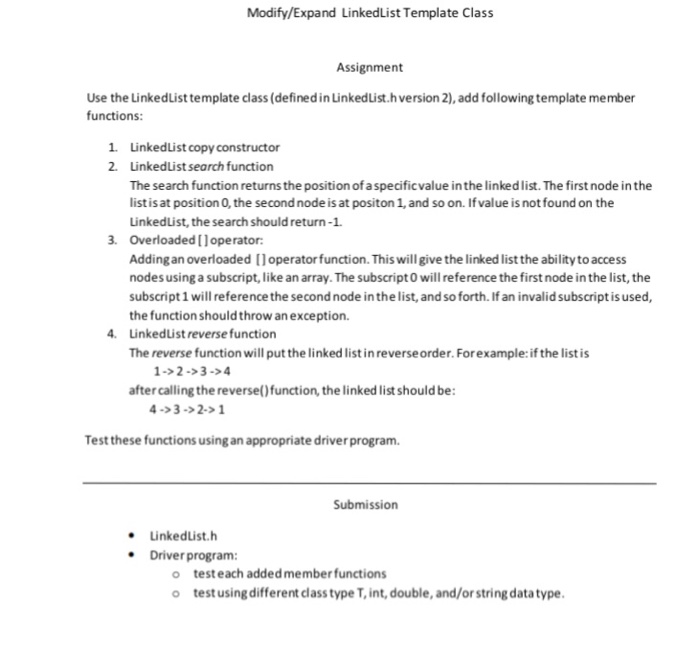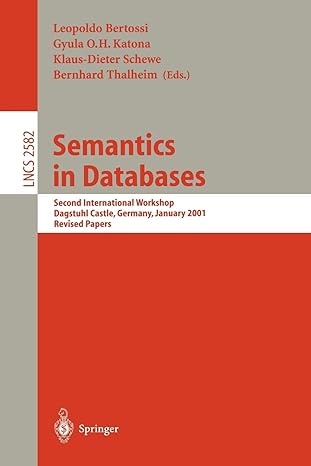Question
// A class template for holding a linked list. // The node type is also a class template. #ifndef LINKEDLIST_H #define LINKEDLIST_H //********************************************* // The
// A class template for holding a linked list.
// The node type is also a class template.
#ifndef LINKEDLIST_H
#define LINKEDLIST_H
//*********************************************
// The ListNode class creates a type used to *
// store a node of the linked list. *
//*********************************************
template
class ListNode
{
public:
T value; // Node value
ListNode
// Constructor
ListNode (T nodeValue)
{ value = nodeValue;
next = NULL;}
};
//*********************************************
// LinkedList class *
//*********************************************
template
class LinkedList
{
private:
ListNode
public:
// Constructor
LinkedList()
{ head = NULL; }
// Destructor
~LinkedList();
// Linked list operations
void appendNode(T);
void insertNode(T);
void deleteNode(T);
void displayList() const;
};
//**************************************************
// appendNode appends a node containing the value *
// pased into newValue, to the end of the list. *
//**************************************************
template
void LinkedList
{
ListNode
ListNode
// Allocate a new node and store newValue there.
newNode = new ListNode
// If there are no nodes in the list
// make newNode the first node.
if (!head)
head = newNode;
else // Otherwise, insert newNode at end.
{
// Initialize nodePtr to head of list.
nodePtr = head;
// Find the last node in the list.
while (nodePtr->next)
nodePtr = nodePtr->next;
// Insert newNode as the last node.
nodePtr->next = newNode;
}
}
//**************************************************
// displayList shows the value stored in each node *
// of the linked list pointed to by head. *
//**************************************************
template
void LinkedList
{
ListNode
// Position nodePtr at the head of the list.
nodePtr = head;
// While nodePtr points to a node, traverse
// the list.
while (nodePtr)
{
// Display the value in this node.
cout value
// Move to the next node.
nodePtr = nodePtr->next;
}
}
//**************************************************
// The insertNode function inserts a node with *
// newValue copied to its value member. *
//**************************************************
template
void LinkedList
{
ListNode
ListNode
ListNode
// Allocate a new node and store newValue there.
newNode = new ListNode
// If there are no nodes in the list
// make newNode the first node
if (!head)
{
head = newNode;
newNode->next = NULL;
}
else // Otherwise, insert newNode
{
// Position nodePtr at the head of list.
nodePtr = head;
// Initialize previousNode to NULL.
previousNode = NULL;
// Skip all nodes whose value is less than newValue.
while (nodePtr != NULL && nodePtr->value
{
previousNode = nodePtr;
nodePtr = nodePtr->next;
}
// If the new node is to be the 1st in the list,
// insert it before all other nodes.
if (previousNode == NULL)
{
head = newNode;
newNode->next = nodePtr;
}
else // Otherwise insert after the previous node.
{
previousNode->next = newNode;
newNode->next = nodePtr;
}
}
}
//*****************************************************
// The deleteNode function searches for a node *
// with searchValue as its value. The node, if found, *
// is deleted from the list and from memory. *
//*****************************************************
template
void LinkedList
{
ListNode
ListNode
// If the list is empty, do nothing.
if (!head)
return;
// Determine if the first node is the one.
if (head->value == searchValue)
{
nodePtr = head->next;
delete head;
head = nodePtr;
}
else
{
// Initialize nodePtr to head of list
nodePtr = head;
// Skip all nodes whose value member is
// not equal to num.
while (nodePtr != NULL && nodePtr->value != searchValue)
{
previousNode = nodePtr;
nodePtr = nodePtr->next;
}
// If nodePtr is not at the end of the list,
// link the previous node to the node after
// nodePtr, then delete nodePtr.
if (nodePtr)
{
previousNode->next = nodePtr->next;
delete nodePtr;
}
}
}
//**************************************************
// Destructor *
// This function deletes every node in the list. *
//**************************************************
template
LinkedList
{
ListNode
ListNode
// Position nodePtr at the head of the list.
nodePtr = head;
// While nodePtr is not at the end of the list...
while (nodePtr != NULL)
{
// Save a pointer to the next node.
nextNode = nodePtr->next;
// Delete the current node.
delete nodePtr;
// Position nodePtr at the next node.
nodePtr = nextNode;
}
}
#endif

Step by Step Solution
There are 3 Steps involved in it
Step: 1

Get Instant Access to Expert-Tailored Solutions
See step-by-step solutions with expert insights and AI powered tools for academic success
Step: 2

Step: 3

Ace Your Homework with AI
Get the answers you need in no time with our AI-driven, step-by-step assistance
Get Started


